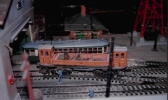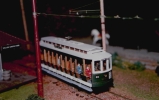The Valhalla Transit Company is an O gauge, 10' x 30' layout. It features operating overhead and two rail, some street running and other on ties on P-R-W (Private Right-of-Way). The operation is manual with electric switches (approximately 15) being thrown at important points with spring-thrown and passive switches being the typical operational mode. Three transformers operate the layout with one being reserved for the Willow Grove amusement park section. The cars are models of Philadelphia prototypes such as the Nearside, Hog Island, Peter Witt, PCC Air and All-Electric Cars as well as the double-end city car and Differential dump Car. The layout has been featured twice in Traction Prototypes and Models and has appeared on various segments of Seward's Trolley Production Company videos. Most structures on the layout are either kit-bashed or scratch-built with use of Philadelphia city sites as visual cues for the operation. The layout is always being worked on as there is now an operating regional train line (Chestnut Hill) with Pennsy O-scale MUs making its way on a point-to-point PRW over Germantown Avenue.
 | Unlike its PTC prototype, Valhalla Transit kept its fleet in as-delivered liveries. The rear of the car barn (scratch-built) features an off-hour array of Philadelphia cars: the 1947 all-electric 2100 series featured on Route 6 (Willow Grove), #2011 Air car from the original 1938 St. Louis car company 20-car order serving Route 53-Wayne Avenue, a Hog Island Brill-built 4-motor 4000 series serving Route 60, and an off-line Birney car used for charters-both in PRT colors. All-Electric built by Jean Deschenes, Air Car and Birney finished by Bill Weber, Hog Island built from Copeland Kit by Allen Hirsh |
 | A typical post-Depression scene of Philadelphia: a coal truck delivering its load while the 4000-series Brill inches its way past. Buildings are scratch-built and from kits. |
 | PRT had scrapped all of its open cars by 1921; Valhala Transit kept at least one Brill-built in 1899 #1164 (built by Jean Deschenes) to serve its Willow Grove Park crowds in the summer. Here it is seen crossing the S-shaped trestle returning to the carhouse on its private right-of-way. |
 | A panoramic view of Willow Grove Park; the carrousel and Ferris Wheel are scratch-buiit, picnic benches are kit-built; two refreshment benches serve the park patrons. The Souza Band is featured this weekend. |
 | The Nearside car (6618) Brill-built in 1912 (finished by Bill Weber) sits on the service track partially obscured by the Differential Dump Car used by Valhalla Transit to deliver the materiel of trolley operation. The service vehicle W-37 was built by Brill in 1923 using the dumping apparatus of the Findlay, Ohio Differential Car Company. The car was scratch-built by Allen Hirsh, using Q-car underbody and trucks. 6618, used as an instruction car by PRT/PTC, exists today at the Seashore Trolley Museum In Kennebunkport, Maine waiting for restoration. |
 | Mermaid loop features a scratch-built service truck with lineman
servicing the overhead frog while the motorman of the Peter Witt 8035, Brill-built, 1923, and finished from a Q-Car kit waits patiently for the repair to be completed. Track rehabilitation causes major delay- the crossover is finally being removed. Note the Corgi PCC- just clearing the track gang. Trolley Waiting Room and generating sub-station can be found on Germantown Avenue In the Mt. Airy section of Philadelphia awaiting restoration of trolley service on Route 23.
|
 | Luzerne Car House finds a Route 53 St. Louis Air car (finished by Bill Weber) #2011 crossing the Willow Grove Park turn-out. Car House is scratch-built from wooden strips, cardboard, complete with a clerestory roof. Every layout needs a carhouse to gather in the fleet. The use of single bracket poles is exclusive to Luzeme Street and the P-R-W to and around the amusement park. |
 | All-Electric PCC car (St. Louis, 1947) #2141 glides down Luzerne Street still in its as-delivered gray roof with red striping, cream windows, dark green below the maroon belt. The PCC was scratch-built by Jean Deschenes. |
 | Crossover action in front of the carhouse. The Birney car #5 In PRT Livery crosses onto westbound track while the double-ended city car #5313 (built by Jean Deschenes) signed for Route 59- Bustleton waits for passage. Pepsi signs come from actual photos Of Philly cars enlarged to O scale. |
 | Note the traction sand box so typical of Philadelphia streets. There are about a dozen strategically located throughout the layout. Scrap wood, brass hinges and the omnipresent hunter green paint is all that is needed. Note as well the scratchbuilt lit billboards with TastyKake and Good and Plenty advertisement. Locally sold products add an air of authenticity to any scene. I modified a 1953 Ford $2 pick-up truck with a wooden stake body for transporting materiel. Thanks, Bill for the PTC decals. The PRT Hog island car still is resplendent in its orange and cream livery, the orange-tan roof being replaced with a gray paint in the early forties. The car still has its radial couplers although it no longer is MU'ed. |
 | The Trolley Waiting Room on Knorr Street hosts a Coca-Cola machine and several patient passengers. The structure (which is a converted Lionel station) is adjacent to two city cars- the #8035 Route 50 Peter Witt and the Route 59 double-ended city car #5313, both in circa 1948 PTC livery. Window bars or window screens? Take your choice. Both were prototypically used. One Sunday afternoon I added underbody-mounted pull-bars for car towing. The addition of such items provides the realistic touch that the true traction entushiast looks for. |
 | The Brill-built 1899 Open Car features Brill M22 trucks and a center-mounted pole that actually revereses the car. The Philadelphia cars had double trucks and a center aisle to afford saftey to the conductor and passengers. The car is departing the Willow Grove Park station adjacent to the amusement park. The P-R-W features flex track from Old Pullman and single bracket poles from John Pilling. A Jean Deschenes-built car, he had to modify a set of trucks. The advertising on the front of the car announces the Souza Band's performances at the park. |